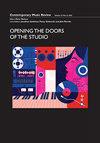‘Androgynous Music’: Pauline Oliveros’s Early Cybernetic Improvisation
IF 0.1
2区 艺术学
0 MUSIC
引用次数: 0
Abstract
In the late 1950s and early 1960s, Pauline Oliveros developed new techniques for improvising with new electronic instruments, which she described using language and metaphors from cybernetics and information theory. First using just a tape recorder, and later using a series of tape recorders connected to an unstable pair of oscillators, Oliveros created what she later called a ‘very unstable nonlinear musicmaking system’ (Oliveros, Pauline. 2016a. “Improvising Composition: How to Listen to the Time Between.” In Negotiated Moments: Improvisation, Sound, and Subjectivity, edited by Gillian H. Siddall, and Ellen Waterman, 75–90. Durham, NC: Duke University Press). By positioning herself as only one member of an instrumental system that facilitated the self-regulating flow of sound as signal—operating as air pressure waves, electrical waves, psychoacoustic phenomena, and even human consciousness—Oliveros began to reconceptualize the role of her body in musical performance. By the early 1970s, Oliveros began to embrace the new kinds of musical performance and musical subjectivities produced by this system as a part of her exploration of gender in music, positing the concept of ‘androgynous music’—defined as music that is simultaneously ‘linear’ and ‘nonlinear’. Oliveros thought of her performance practice as one that could destabilise socially constructed musical identities of composition, performance, and listening, and also integrate different modalities of interacting with musical ‘signal’. This article maps Oliveros’s cybernetic, improvisatory practices with her earliest electronic systems, showing how her performance within these systems laid the groundwork for her later theorisations of technology, gender, and the body.“双性恋音乐”:宝琳·奥利韦罗斯早期的控制论即兴创作
在20世纪50年代末和60年代初,Pauline Oliveros开发了用新电子仪器即兴创作的新技术,她使用控制论和信息论中的语言和隐喻进行了描述。奥利韦罗斯最初只使用了一台录音机,后来又使用了一系列连接到一对不稳定振荡器上的录音机,她创造了一个她后来称之为“非常不稳定的非线性音乐制作系统”(Oliveros,Pauline。Siddall和Ellen Waterman,75–90岁。北卡罗来纳州达勒姆:杜克大学出版社)。奥利韦罗斯将自己定位为一个乐器系统中的唯一一员,这个系统促进了声音作为信号的自我调节——作为气压波、电波、心理声学现象,甚至人类意识——她开始重新定义自己身体在音乐表演中的角色。到20世纪70年代初,奥利韦罗斯开始接受这种系统产生的新型音乐表演和音乐主观主义,这是她探索音乐中性别的一部分,提出了“雌雄同体音乐”的概念——定义为同时“线性”和“非线性”的音乐。奥利韦罗斯认为,她的表演实践可能会破坏社会构建的音乐创作、表演和聆听身份,并整合与音乐“信号”互动的不同模式。这篇文章将Oliveros的控制论、即兴实践与她最早的电子系统相结合,展示了她在这些系统中的表现如何为她后来的技术、性别和身体理论奠定基础。
本文章由计算机程序翻译,如有差异,请以英文原文为准。
求助全文
约1分钟内获得全文
求助全文
来源期刊

Contemporary Music Review
MUSIC-
CiteScore
1.00
自引率
25.00%
发文量
48
期刊介绍:
Contemporary Music Review provides a forum for musicians and musicologists to discuss recent musical currents in both breadth and depth. The main concern of the journal is the critical study of music today in all its aspects—its techniques of performance and composition, texts and contexts, aesthetics, technologies, and relationships with other disciplines and currents of thought. The journal may also serve as a vehicle to communicate documentary materials, interviews, and other items of interest to contemporary music scholars. All articles are subjected to rigorous peer review before publication. Proposals for themed issues are welcomed.
 求助内容:
求助内容: 应助结果提醒方式:
应助结果提醒方式:


